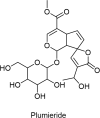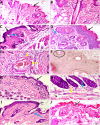Plumieride as a novel anti-fungal and anti-inflammatory iridoid against superficial candidiasis in mice
- PMID: 38858704
- PMCID: PMC11163697
- DOI: 10.1186/s12906-024-04508-z
Plumieride as a novel anti-fungal and anti-inflammatory iridoid against superficial candidiasis in mice
Abstract
In the past few decades, there has been a notable rise in the occurrence of several types of candidiasis. Candida albicans is the most common cause of superficial fungal infections in humans. In this study, plumieride, one of the major iridoids from Plumeria obtusa L. leaves, was isolated and investigated for its potential against Candida albicans (CA)-induced dermatitis in mice. qRT-PCR was done to assess the impact of plumieride on the expression of the major virulence genes of CA. Five groups (n = 7) of adult male BALB/c mice were categorized into: group I: non-infected mice; group II: mice infected intradermally with 107-108 CFU/mL of CA; group III: CA-infected mice treated with standard fluconazole (50 mg/kg bwt.); group IV and V: CA-infected mice treated with plumieride (25- and 50 mg/kg. bwt., respectively). All the treatments were subcutaneously injected once a day for 3 days. Skin samples were collected on the 4th day post-inoculation to perform pathological, microbial, and molecular studies. The results of the in vitro study proved that plumieride has better antifungal activity than fluconazole, manifested by a wider zone of inhibition and a lower MIC. Plumieride also downregulated the expression of CA virulence genes (ALS1, Plb1, and Hyr1). CA-infected mice showed extensive dermatitis, confirmed by strong iNOS, TNF-α, IL-1β, and NF-κB genes or immune expressions. Whereas the treatment of CA-infected mice with plumieride significantly reduced the microscopic skin lesions and modulated the expression of all measured proinflammatory cytokines and inflammatory markers in a dose-dependent manner. Plumieride interfered with the expression of C. albicans virulence factors and modulated the inflammatory response in the skin of mice infected with CA.
Keywords: Candida albicans; Gene expression; Inflammation; Pathology; Plumieride.
© 2024. The Author(s).
Conflict of interest statement
There is no conflict of interest among authors.
Figures





References
-
- Shan Y, Lei J, Zhang L, Fan T, Wang M, Ma Y, Design Synthesis, and Biological Evaluation of Chalcone Derivatives as Novel Anticandidal agents. Chem Nat Compd. 2015;51:620–5. doi: 10.1007/s10600-015-1369-6. - DOI
MeSH terms
Substances
LinkOut - more resources
Full Text Sources
Miscellaneous

